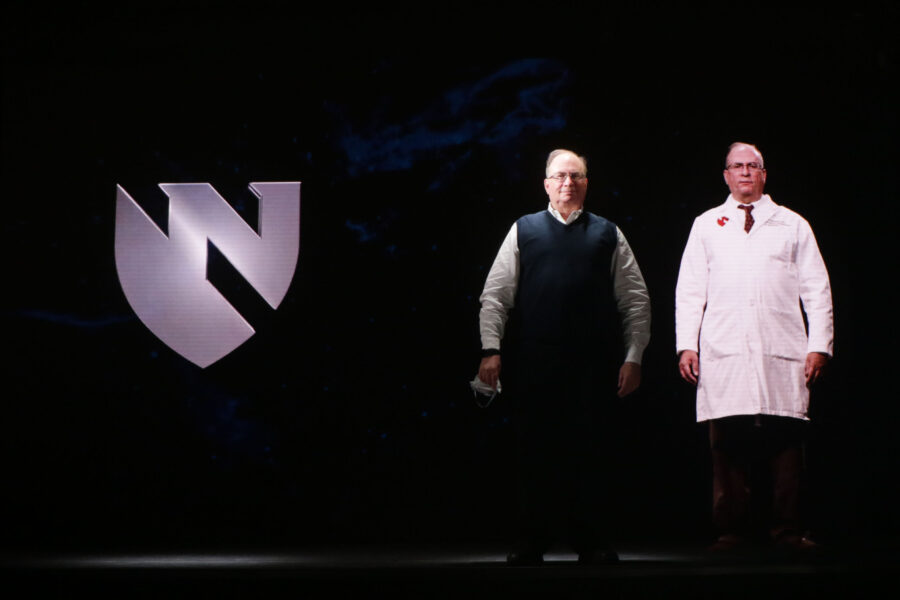When important visitors tour the iEXCEL facilities at the Davis Global Center, the first stop on the tour is usually the holographic theater. There, VIPS will be greeted by a hologram of UNMC Chancellor Jeffrey P. Gold, MD. Or possibly University of Nebraska System President Ted Carter.
Or Robert Norgren, PhD, professor in the UNMC Department of Genetics, Cell Biology and Anatomy.
Dr. Norgren, co-director of the UNMC College of Medicine’s neuroscience educational block, was an enthusiastic early adopter of the iEXCEL simulation technology – even teaching at the iEXCEL iWall while it was still in the Sorrell Center.
“As soon as I heard about the iWall, I was immediately interested,” he said.
Dr. Norgren was not only attracted by the possibilities in the new technology, he was excited by the willingness of the iEXCEL animators to work with him to translate his curriculum materials into more interactive, visually arresting presentations.
“They have a lot of different resources there, and of course there’s a bit of a learning curve to learn how to use those resources to their best advantage,” he said. “We want it to be as interactive as possible, and the nature of the interaction varies depending on the technology that’s available to us.”
Dr. Norgren was so impressed by the effect of the iEXCEL materials on the students that he and his co-directors moved the neuroanatomy lab over to the Davis Global Center, the first medical class to make such a move.
Dr. Norgren’s co-directors for the Neurosciences Block are Shannon Lynch, MD, Riley Machal, MD, and Erin Smith, MD. Drs. Lynch and Smith use the Davis Global Center for clinical simulations in the Neuroscience Block during “Clinical Skills” activities.
One of the showpieces of the block’s iEXCEL curriculum – indeed, the piece spotlighted in Dr. Norgren’s version of that “Welcome to iEXCEL” holographic presentation – are two larger-than-life 3D holograms of brains, one neurotypical and one showing the results on Huntington’s disease.
Students enjoy working in the iEXCEL facility. Dr. Norgren described the advantages of doing case reports on the interactive iWall.
“I’ll discuss a case describing symptoms in a patient that would be neuro-related, and the students will have to go up and draw on the iWall where they think the lesion is,” Dr. Norgren said. “I’ll be walking around and be open for discussions. Then we, as a group, step back, look at what each of them have done, and we discuss it as a group.
“The students have told me they like that it really pushes them. They have to problem-solve in real time. And even if they didn’t know the answer, it’s a strong motivator for them to go back and study the gaps in their understanding.”
In the next academic year, Dr. Norgren and his co-directors hope to expand the use of the holographic theater. One of his co-directors, Erin Smith, MD, did a neurology consultation with a simulated patient, and the examination was recording as a hologram.
“This type of cutting-edge technology adds value over a simple PowerPoint presentation,” Dr. Norgren said.
In addition, he said, the iEXCEL team makes it easy for faculty to access the technology.
“I wouldn’t say it’s a huge amount of my time – what they do is far more time-intensive and requires a lot of technical skills,” he said. “They are outstanding collaborators. Every time I go over there I’m amazed by the quality of the equipment, the quality of the expertise. I think it is truly a world-class facility. When I used it last year, I couldn’t believe I had access to that level of technology to teach with – I remember the days when we had carousel slide projectors.”
With UNMC’s push for more interaction in the medical curriculum to increase student engagement, Dr. Norgren said, iEXCEL offers educators a great deal.
“I can tell you, students will be grateful to instructors who go over there and use the new technology. There aren’t be any barriers to adoption.”
